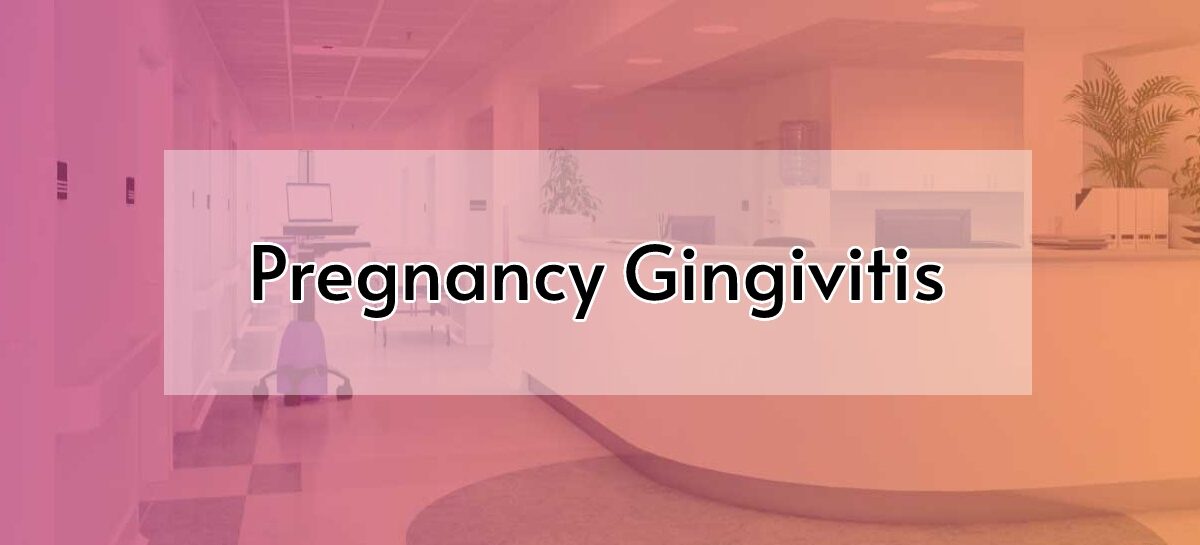Definition
Gingiva is the part of the oral mucosa that covers the alveolar processes of jaws and surrounds the neck of teeth. Gingivitis is an inflammation of the gingival tissue, characterized by areas of redness, bleeding and swelling. Gingivitis is limited to the gingival epithelium and connective tissue. Gingivitis is usually caused by the accumulation of plaque around the teeth. Other causes could be drug-induced, systemic conditions, local trauma, genetic or developmental disorders, etc.
One common form of gingivitis, seen in 60% – 70% of women, is pregnancy gingivitis. Gingival inflammation associated with pregnancy has been initiated by dental plaque and exacerbated by endogenous steroid hormones. (1)
Prevalence
An increase in the prevalence and severity of gingival inflammation during pregnancy without plaque association has been reported since the early 1960s. Clinically, pre-existing gingivitis or periodontitis in pregnant women will worsen dramatically.
Pregnancy is a period associated with many physiological changes. These changes affect the whole body including oral health. The variation in the levels of the hormones estrogen and progesterone leads to reduced immunity and thus an increase in the possibility of oral infections. The gingivitis thus caused by hormonal imbalance during pregnancy may become chronic and irreversible if not treated early. Increased estrogen can cause gingival hyperplasia, gingivitis, pyogenic granulomas, dental caries and change in salivary flow (2). The periodontal changes are characterized by increasing periodontal probing depths, bleeding upon probing or mechanical stimulation, and gingival crevicular fluid flow, which disappear postpartum (3). Recent studies further confirmed that gingivitis associated with pregnancy seemed to be dependent on, but unrelated to, the amount of dental plaque accumulation. It seemed that good oral hygiene in pregnancy was able to partially neutralize hormonal effects (4).
Pathogenesis

Clinical Examination
The common signs seen in pregnancy gingivitis are redness, swollen and frail gums and bleeding on palpation or probing (Fig. 1,2). The periodontal signs include attachment loss, increased probing teeth and mobility of teeth. Pyogenic granuloma, a kind of inflammatory hyperplasia, noticed frequently in the oral cavity, is the result of reaction to hormones and discomfort caused by irritants. When pyogenic granulomas happen during pregnancy, they are called pregnancy tumors. (Fig. 3)

Fig. 1 Red, Swollen & Frail Gums

Fig.2 Bleeding on Probing

Fig. 3 Pyogenic Granuloma
Investigations
No specific investigation is required to diagnose pregnancy gingivitis. This condition is usually diagnosed based on history and clinical examination. An evaluation of the plaque, saliva or gingival crevicular fluid shows an increase in periodontal microflora, which include Prevotella intermedia, Fusobacterium sp, Bacteroides intermedius and Porphyromonas gingivalis. (6)
Treatment Plan
The treatment for pregnancy gingivitis usually involves a thorough scaling to mechanically eliminate the plaque (Fig. 4). The patient is advised to use chlorhexidine mouthwash to maintain good oral hygiene. A study of 823 pregnant women at 13 to 21 weeks’ gestation found that scaling and root planing for periodontitis using local anesthetics as needed did not increase adverse fetal outcomes; however, it did lower preterm birth rates.
 Prevention
Prevention
Good oral hygiene maintenance is the key to prevention of periodontal problems during pregnancy. Performing interventions for prevention and treatment of periodontitis or using local anesthetics during pregnancy have not been found to be associated with an increased risk to the developing fetus. Conversely, adverse pregnancy outcomes, such as LBW, preterm birth and preeclampsia, occur in women who have not received treatment.
Conclusion
Pregnancy gingivitis is a reversible condition that usually subsides postpartum. Timely diagnosis and simple treatment followed by good maintenance and good oral health during pregnancy is important to the overall health of both expectant mothers and their babies.
- Periodontal conditions during the pregnancy associated with periodontal pathogens. Usin MM, Tabares SM, Parodi RJ, Sembaj A J Investig Clin Dent. 2013 Feb; 4(1):54-9.
- Oral health in pregnancy (guidelines to gynaecologists, general physicians & oral health care providers). Kandan PM, Menaga V, Kumar RR J Pak Med Assoc. 2011 Oct; 61(10):1009-14.
- Sex steroid hormones and cell dynamics in the periodontium. Mariotti A Crit Rev Oral Biol Med. 1994; 5(1):27-53.
- Development of a classification system for periodontal diseases and conditions. Armitage GC Ann Periodontol. 1999 Dec; 4(1):1-6.
- High salivary estrogen and risk of developing pregnancy gingivitis.Gürsoy M, Gürsoy UK, Sorsa T, Pajukanta R, Könönen E J Periodontol. 2013 Sep; 84(9):1281-9.
- Gingival changes during pregnancy: II. Influence of hormonal variations on the subgingival biofilm. Carrillo-de-Albornoz A, Figuero E, Herrera D, Bascones-Martínez A J Clin Periodontol. 2010 Mar; 37(3):230-40.



 Dr. Rakesh. U
Dr. Rakesh. U Dr. Kirthana Rao
Dr. Kirthana Rao